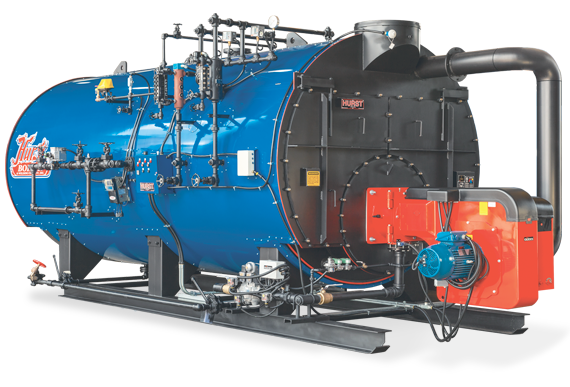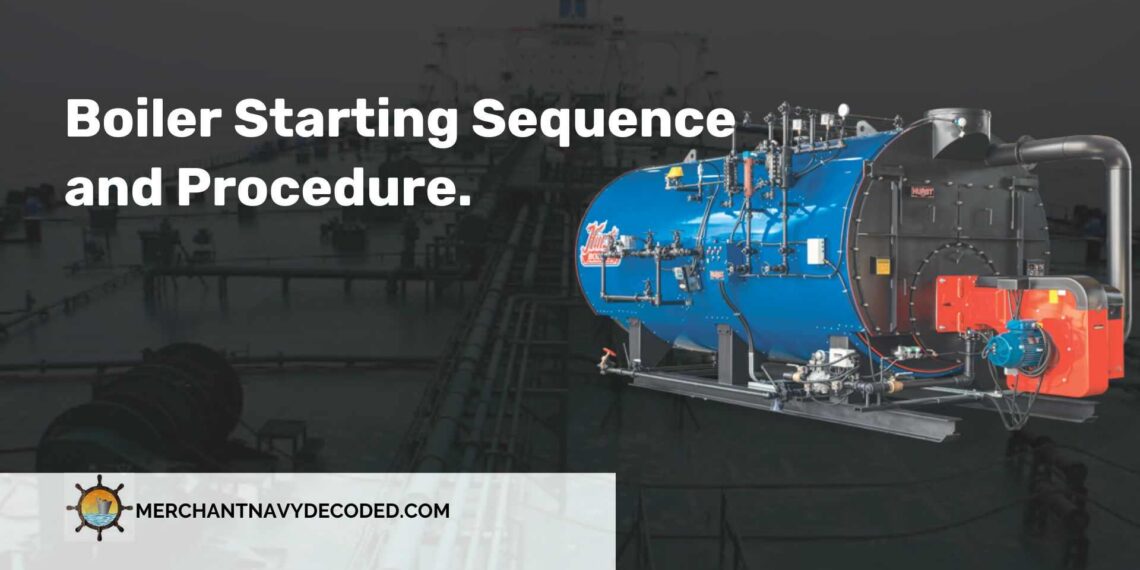Boiler Starting Procedure
Table of contents
1. Overview

The boiler starting procedure ensures safe and efficient operation by following key steps: checking alarms, purging sequences, igniting the pilot burner, verifying main burner ignition, regulating fuel oil flow, and monitoring temperatures and pressures. These actions guarantee optimal combustion and performance during boiler operation.
What is a Boiler? Why do we use a boiler on a ship? Click Here
2. Boiler Starting Procedure Step-by-Step Guide
There are two types of boiler start procedures: manual and automatic. This blog focuses on the manual mode of starting the boiler.
Step 1: Check the Alarm Control Panel and Alarm Status
1.1. Approach the boiler control panel and ensure it is accessible and powered.
1.2. Methodically inspect the control panel for any indications of alarm activation or abnormal readings.
1.3. Verify the status of all critical alarms, including but not limited to:
- Flame failure
- Fail to ignite
- High-high water level
- High water level
- Low water level
- Low-low water level
- Low fuel temperature
- Low pilot fuel temperature
- Low fuel pressure
- Low steam pressure
- Fuel oil valve start
- High steam pressure
- Feed water pressure low
1.4. Take note of any alarms that are currently active or have been triggered recently.
Step 2: Ensure that all alarm indicators are functioning correctly and visible.
Step 3: Lockout Clearance
3.1. Confirm that no active alarms indicate a lockout condition before proceeding.
Step 4. Initiate the pre-purge sequence by starting the Forced Draft (FD) fan, allowing it to run for 180 seconds (3 minutes).
Step 5: Pilot Burner Ignition
4.1. After the pre-purge, ignite the pilot burner.
Step 6: Main Burner Ignition
6.1. Verify if the flame ignites within 5 seconds.
– If yes, proceed to Step 6.
– If no, trigger a fail-to-ignite alarm.
Step 7: Main Burner Activation
7.1. If the flame ignites successfully, start the main burner.
– If yes, proceed to Step 6.
– If no, trigger a flame failure alarm.
7.2. Maintain the flame for 5 seconds.
7.3. After this period, deactivate the pilot burner.
Step 8: Boiler Modulation and Operation
8.1. Initiate boiler modulation to reach the desired set pressure.
Step 9: When the boiler reaches the set pressure, the fuel oil valve remains on standby for further regulation.
9.1. The standby status of the fuel oil valve ensures readiness for emergencies. In a sudden demand for steam, such as during critical operations or emergencies, the fuel oil valve can be promptly opened to reignite the boiler and resume steam production. This standby position enables swift response to unexpected requirements, maintaining operational readiness and ensuring continuity of essential shipboard functions.
Step 10: Conduct a post-purge to clear any remaining gases.
Step 11: Transition the boiler to standby mode.
Step 12: Monitor steam pressure for proper operation.
This sequence ensures safe and efficient boiler operation, responding appropriately to ignition success or failure.
3. Conclusion

Mastering the boiler starting sequence is crucial for onboard ships’ safe and efficient operation. By carefully following each step, including checking vents, fuel valves, and water levels, operators ensure the smooth functioning of the boiler system. While the process may seem complex, it guarantees efficient steam generation, vital for maritime operations’ success. With proper understanding and adherence to the starting procedure, seafarers can maintain boiler integrity and safety, contributing to the smooth sailing of vessels across the seas.
4. Frequently Asked Question
Q1: Before starting the boiler, what alarms should be checked on the control panel?
A1: Before starting the boiler, it’s essential to check for alarms such as flame failure, failure to ignite, high-high water level, high water level, low water level, low-low water level, low fuel temperature, low pilot fuel temperature, low fuel pressure, low steam pressure, fuel oil valve start, high steam pressure, and low feed water pressure.
Q2: What is a fuel oil valve, and why is it important in the boiler start-up process?
A2: The fuel oil valve is a crucial component that controls the flow of fuel to the boiler. It is essential in the start-up process as it regulates the fuel supply, ensuring the correct fuel-air mixture for combustion and safe boiler operation.
Q3: What temperature needs to be maintained during the boiler start-up process?
A3: During the boiler start-up process, temperatures such as fuel temperature and pilot fuel temperature need to be maintained within specified operating ranges to ensure proper combustion and efficient boiler performance.
Q4: What are post-purge and pre-purge, and why are they necessary?
A4: Post-purge and pre-purge are procedures that involve clearing out any residual gases or combustion byproducts from the boiler and associated components before and after combustion. Pre-purge ensures a clean environment for ignition, while post-purge removes any remaining gases after combustion, both crucial for safety and efficiency.
Q5: What is the difference between the main burner and the pilot burner?
| Aspect | Main Burner | Pilot Burner |
| Function | Responsible for primary combustion | Used for ignition, especially with heavy fuel oil |
| Fuel | Heavy Fuel Oil | Marine Gasoline oil oil |
| Atomization | Atomizes fuel into fine droplets for combustion | – |
| Pressure | Operates at higher pressures | – |
| Purpose | The primary source of combustion | Assists in starting combustion, especially at startup |
| Operation | Continuously operates during boiler operation | Operates for a limited period during ignition |
| Dependence | Dependent on initiating the main burner ignition | Dependent on initiating the main burner ignition |
Disclaimer :- The opinions expressed in this article belong solely to the author and may not necessarily reflect those of Merchant Navy Decoded. We cannot guarantee the accuracy of the information provided and disclaim any responsibility for it. Data and visuals used are sourced from publicly available information and may not be authenticated by any regulatory body. Reviews and comments appearing on our blogs represent the opinions of individuals and do not necessarily reflect the views of Merchant Navy Decoded. We are not responsible for any loss or damage resulting from reliance on these reviews or comments.
Reproduction, copying, sharing, or use of the article or images in any form is strictly prohibited without prior permission from both the author and Merchant Navy Decoded.


